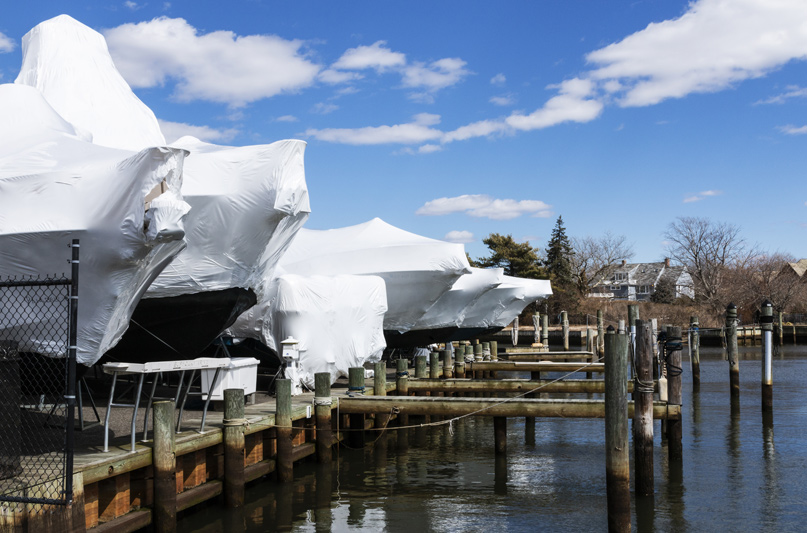
Everything from doing yoga on the foredeck to having dinner in the cockpit changes during winter. No more flip-flops, outdoor dinners, and swims. It is the time boat owners close their hatch and retreat to the heated cabin. The cockpit and deck often become unusable, while the living space shrinks by almost half. Unless you winterize your boat before storing it, it may be challenging to use it once the winter season is over. Preparing a boat for winter storage could involve cleaning the decks, oiling the engine, repairing the propeller, covering the floor, and creating a checklist to use as a reference during the winterizing process.
In some parts of the Pacific Northwest during winter, boats often face potential problems that could call for repair and maintenance. With off-season care techniques, many of these preventable issues can be limited or avoided. One way to improve the appearance and performance of a boat is by taking it through a meticulous winterizing process.
The off-season care requires more than draining the engine’s fluid, pulling the boat out of the water, and adding antifreeze. Experts urge boat owners to always refer to the manufacturer’s manual before starting to prep their marine vessel for the winter season. Consider talking to a professional for boat maintenance tips, especially if it is your first time to winterize a boat. In truly cold areas, finding appropriate storage for a boat is essential during the colder months. You might need to check your boat frequently throughout the winter to prevent leaks caused by ice exposure and snow buildup. Here are some basic boat care tips during the colder winter months.
Cleaning
It might be necessary to clean both the outside and inside of a boat before storing it. It’s a good idea to pressure wash the exterior of the boat to remove any dirt or residue. However, make sure to use manufacturer-specified cleaning processes for vessels with vinyl windows and soft surfaces.
Inspecting and steam cleaning everything from upholstery, cabinets, interior drawers, shafts, and propellers before storage is crucial. However, make sure things such as fire extinguishers, flares, and electronics are removed from a marine vessel before cleaning begins. Cabinets and drawers should be emptied and wiped before they are cleaned. Remove cushions and turn them on their edge to allow for the free flow of air. Otherwise, store them in a climate-controlled place so that they don’t become saturated with moisture or water. You may need to limit your boat exposure to moisture while it is in storage. Desiccating products and dehumidifiers can aid in that.
Covering
Covering a boat during winter is a practice that shouldn’t be overlooked. It may seem unimportant to cover a boat with an expensive, premium material in the off-season, but these covers are an integral part of caring for a marine vessel. The first step is finding a reliable boat cover vendor.
You can use simple tarps as a cover, but that may call for the need for a barrier between the boat and the tarp. However, take caution with some tarps, especially those that are made from abrasive materials, as they can shift and damage your boat when they are exposed to wind. Other materials common for making boat covers include polyester, acrylic, vinyl, and cotton.
Boat covers can either be pre-made or custom-made to the specifications of your boat. However, for longevity and protection, a boat cover made from a polyester fiber can be the best choice. Polyester covers are more resistant to mildew and water than any other material used for covering a marine vessel.
Maintenance
Inspecting the propeller is often easier when the boat is at dry dock storage. With the marine vessel out of the water, it is easier to check for any necessary maintenance. Areas that need to be checked include leaky seals, corroded zinc anodes, and faulty bearings. Though all these repairs are possible while the boat is in the water, they are much easier when the marine vessel is at a dry dock.
Oiling
Oiling a marine vessel during the off-season is crucial. After all, the engine is the one that propels the ship in the water. Engine inspection should start with the basics, including checking the oil levels. Boat oil should be checked every 50-100 running hours, and remember to run the engine when changing the oil so that the oil can drain. Then check for any leaks and keep monitoring oil levels so that lubrication doesn’t run low.
Checklist
Even the most experienced boat owners often forget a step when prepping their vessels for the winter season. Using a checklist while preparing a marine vessel for the winter can help you cover all the bases. A checklist will ensure that you touch on everything during the winterizing process.


